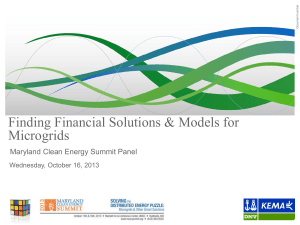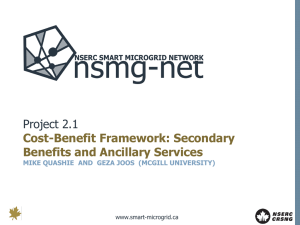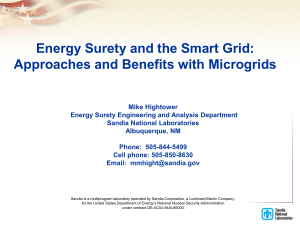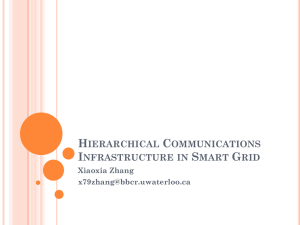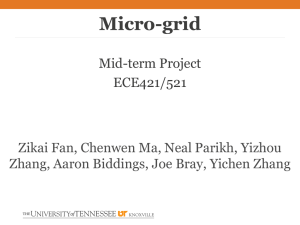1_Aster Capital_Fabio Lancelotti
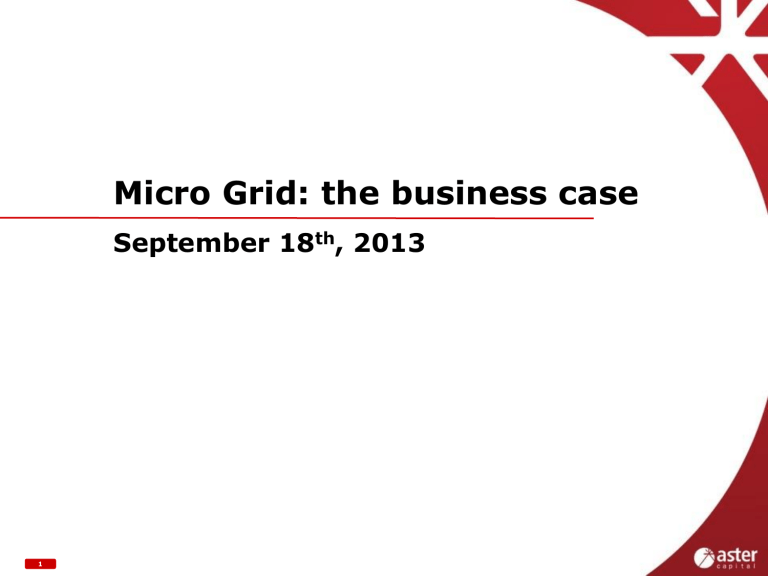
1
Micro Grid: the business case
September 18 th , 2013
Table of Contents
1.
Intro to Aster
2.
Why bother about Micro-Grid
3.
The Business Case
1. Distributed Energy Storage
2. Microgrid in remote areas - mining
4. Drivers of Competitiveness
5. Identifying market opportunities and biz models
2
3
Table of Contents
1. Intro to Aster
2. Why bother about Micro-Grid
3. The Business Case
1. Distributed Energy Storage
2. Microgrid in remote areas - mining
4. Drivers of Competitiveness
5. Identifying market opportunities and biz models
4
Micro-Grid: what?
What is a Microgrid?
The Microgrid Exchange Group defines a microgrid as:
“A microgrid is a group of interconnected loads and distributed energy resources (DER) within clearly defined electrical boundaries that acts as a single controllable entity with respect to the grid . A microgrid can seamlessly connect and disconnect from the grid to enable it to operate in both grid-connected or islandmode.”
5
Why Micro-Grid: renewable integration issues
6
Voltage out of range
Micro-Grid: challenges faced
Every microgrid faces a set of technical challenges similar to those that the main grid encounters, including
7
•
Distributed Energy Resources (DER) Component Connection to Microgrid -
How do DER units join the microgrid and whose responsibility is it to figure out how to make safe interconnections?
• DER Component Output Balancing - How does the microgrid balance the resources and technical operating constraints of different types of DER components (e.g., solar, wind, fuel cells, microturbines, combined heat and power generators, batteries, etc.)?
• Facility Load Fluctuations - How does the microgrid accommodate highly variable changes in the attached load?
•
System Electrical Stability - How does the microgrid balance loss of voltage and frequency control?
•
Grid Interconnection & Islanding - How do the DER units communicate with the microgrid during normal operation and when the main grid defaults (especially when it shuts down) how do the DER units reconnect?
• System Performance - How does the microgrid optimize the DER mix and the energy output or environmental performance of each DER unit relative to external conditions (e.g., weather conditions, electricity prices, environmental regulations)?
… but we will have a good answer to technical problems…. -
the issue is more: what are the economics?
Table of Contents
1.
Intro to Aster
2.
Why bother about Micro-Grid
3.
The Business Case
1. Distributed Energy Storage
2. Microgrid in remote areas - mining
4. Drivers of Competitiveness
5. Identifying market opportunities and biz models
8
Business case: reduce energy bills by reducing peaks
In the US, C&I customers are charged both for energy and demand charge
High Demand Charges*:
3 largest Californian utilities
Smooth the peaks to reduce monthly bill What solution?
15kW peak reduction
$3k+ saved per year
What technology/service can provide value here?
• Racks of batteries and power converters
• Real-time measurement of the electricity consumed
• Software analytics to forecast the peaks and control the batteries
9 *charges are per 15min interval
Business case: reduce energy bills by reducing peaks
Business case: 2013 Business case: 2016
Economics 2013 - load shedding only
Hardware
GM%
0%
10%
20%
30%
Selling price
($/kW)
$ 1 404
$ 1 560
$ 1 755
$ 2 006
Revenues
($/kW/y)
$ 230
$ 230
$ 230
$ 230
65%
Payback with
SGIP
2,1
2,4
2,9
4,0
30%
Payback with
ITC
4,3
4,7
5,3
6,1
0%
Payback unsubsidized
6,1
6,8
7,6
8,7
Example of business case of a battery integrator (1)
• In California, there is a specific subsidy designed to promote the use of distributed storage called the Self Generation Investment Program (SGIP) which covers up to 65% of the total cost of distributed storage systems. This program is in place through end of 2015
• Other states have similar programs and incentives
Economics 2016 - load shedding only
Hardware
GM%
0%
10%
20%
30%
Selling price
($/kW)
$ 769
$ 854
$ 961
$ 1 098
Revenues
($/kW/y)
$ 259
$ 259
$ 259
$ 259
65%
Payback with
SGIP
1,0
1,2
1,3
1,5
30%
Payback with
ITC
2,1
2,3
2,6
3,0
0%
Payback unsubsidized
3,0
3,3
3,7
4,2
Example of business case of a battery integrator (2)
• By early 2016, this load shedding application will result in a 3-year payback with the federal
30% tax credit or 4-5 years without any incentives at all. This represents better paybacks than solar system implementation
• Including additional revenues streams and financing structures / leasing plans paybacks are even more interesting
Reasonable ROI with incentives
Achievable 4-5 year pay-back without no incentives (opportunity to self-finance)
10
Business case: reduce energy bills by reducing peaks
Distributed capacities can be aggregated to provide grid services
• As soon as several MWs of localized distributed energy storage are deployed, they can provide utilities and players in the wholesale market with services to optimize and balance the distribution grid
• Portfolio effect (not the same needs at the same time)
• Existing market for demand response
• Regulators pushing for the opening of wider grid services markets (ex. PJM):
• Capacity at peak (demand response) to match a peak in demand - $60 to $175/kW per year
• Energy arbitrage - $50 to $90/kW per year
• Ancillary services such as frequency regulation and non/spin reserves - $30 to $50/kW per year
Additional revenues, shorter paybacks
11
Table of Contents
1.
Intro to Aster
2.
Why bother about Micro-Grid
3.
The Business Case
1. Distributed Energy Storage
2. Microgrid in remote areas - mining
4. Drivers of Competitiveness
5. Identifying market opportunities and biz models
12
High level business cases
13
Remote Areas: case of mines
14
Remote Areas: the typical configuration
15
Typical Functioning
• Priority for solar power when available
• Diesel engine runs in variable speed mode to charge the battery and supply the load
• Battery management control included
• Engine management control included
• Provision for running the engine at constant speed mode to deliver three phase 415V, 50 Hz supply.
• The engine, the generator, battery monitoring system, engine management controller, 250 litre fuel tank – all in an acoustic enclosure (less than 70dB at 1m)
• Maximum Power Point Tracking Solar Charge Controller
• High efficiency bidirectional inverter/charger
• Complete system wired and housed in a 20ft shipping container
Remote Mine: business case
Grid Stabilizer/Mgmt of load is key
BHP Billiton’s nickel mine in Western Australia is the third-largest producer of nickel concentrate in the world. Ore is extracted from 1,000 meters underground with a large, electrically driven winder, which at 8.5 megawatts (MW) of demand shift over 120 seconds is a large cyclic load, given the unit’s average power consumption is just 2 MW. To upgrade the winder’s power supply,
BHP installed a 1 MW Grid stabilizer system, which reduced the total demand shift to 6.5 MW while adding 1 MW of spinning reserve to the system.
Its flywheel-based energy storage system provides peak lopping and overcomes transient and cyclic loads on grid connected or isolated systems. The mine was able to increase winder production without affecting power system reliability.
16
Table of Contents
1.
Intro to Aster
2.
Why bother about Micro-Grid
3.
The Business Case
1. Distributed Energy Storage
2. Microgrid in remote areas – mining
4. Drivers of Competitiveness
5. Identifying market opportunities and biz models
17
Distributed energy storage: Startup competitive landscape
Startup players
• Providers of distributed energy storage for load shedding, utility-controlled or renewable integration
• Mostly Product-push companies with unclear business cases
Potential new entrants
• Battery manufacturers
Going downstream to keep value and find new applications in this oversupply market
• UPS Providers
Having the technology and some markets channels in hands
• Energy Services Companies
Providing demand-side management services
• BMS Providers and Software companies
Developing demand-management offers on top of their BMS - Schneider Electric, Siemens,
Johnson Controls, Honeywell, BuildingIQ,
FirstFuel, SkyFoundry, Gridium, Viridity Energy
18
Key competitive advantages
Software analytics, Straightforward value proposition, Product compactness, Initial traction market traction
How to maintain them?
Business model innovation (developed in the solar industry), Become market leader and build a brand, Lock market channels
Table of Contents
1.
Intro to Aster
2.
Why bother about Micro-Grid
3.
The Business Case
1. Distributed Energy Storage
2. Microgrid in remote areas - mining
4. Drivers of Competitiveness
5. Identifying market opportunities and biz models
19
Distributed energy storage: Main drivers that will lead expansion
20
Micro-grid in remote areas – mines: Market size and opportunity
Driven largely by the falling price of solar photovoltaics, the global remote* microgrid market was 349 megawatts (MW) of generation capacity in 2011, of which 215MW are island microgrids. That will expand to over 1.1 gigawatts (GW) by 2017, an amount that at least equals all other microgrid segments combined. The remote microgrid market is expected to grow to $10.2 billion by 2017, and investors and suppliers are starting to take notice.
This subsegment of the remote microgrid market is the least mature, but also boasts the highest growth rates due to an expected upswing in interest in shifting to more sustainable energy strategies for sites controlled by large multinationals. Globally, nearly 75% of existing mines are remote operations, though very few deploy renewable energy generation. At present, the total capacity of industrial remote mine systems is estimated to be 35 MW. This remote microgrid subsegment boasts the highest CAGR in the average scenario - 40.0% - and represents corresponding revenue of $1.8 billion by 2017
21 *remote means: not connected or with very weak links to the Grid
Annexes
22
Remote Micro-Grid – Differenting Offering
Exemplificatory
23
Increasing more value drivers
Customized vs. standardization/commoditization
Unit economics
As of today, 4 year payback in California
Costs 2013 $ 54 kW and kWh unit
PowerStore hardware (18kW)
PowerMonitor hardware
Ancillary hardware
Installation cost (fixed)
Installation cost (per PowerStore)
Cost to Stem
$ 24 168
$ 1 032
$ 630
$ 900
$ 250
Nb
$ 3
$ 1
$ 1
$ 1
$ 3
Cost to Stem
$ 72 504
$ 1 032
$ 630
$ 900
$ 750
Cost per kW $ 1 404
Economics 2013 - load shedding only
Hardware
GM%
0%
10%
20%
30%
Selling price
($/kW)
$ 1 404
$ 1 560
$ 1 755
$ 2 006
Revenues
($/kW/y)
$ 230
$ 230
$ 230
$ 230
65%
Payback with
SGIP
2,1
2,4
2,9
4,0
30%
Payback with
ITC
4,3
4,7
5,3
6,1
0%
Payback unsubsidized
6,1
6,8
7,6
8,7
PowerBlades
Battery Cells (1 kWh)
Battery BMS+ (1 kWh)
Other Components
$ 1 500
$ 525
$ 251
$ 1 200
By 2016, 3-year target despite reduced incentives
Payback based including 30% gross margin, Stem
24

